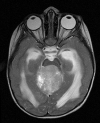Posterior fossa tumor in a 2 year-old girl
- PMID: 19291003
- PMCID: PMC8094713
- DOI: 10.1111/j.1750-3639.2009.00279.x
Posterior fossa tumor in a 2 year-old girl
Abstract
We report a case of a 2 year-old girl who presented with three weeks' history of deterioration of walking, then became unable to walk and later she developed projectile vomiting. Neurological examination revealed bilateral papilledema, nystagmus, and truncal ataxia with intention tremor. Radiological studies showed an enhancing mass in the posterior fossa extending from the cerebellum to the roof of the fourth ventricle. The tumor was diagnosed as an embryonal tumor with abundant neuropil and true rosettes (ETANTR). The tumor cells in the neuroblastic component were diffusely positive for synaptophysin and CD56, with scattered positive cells for glial fibrillary acidic protein. The true rosettes were only positive for vimentin. Ki67 showed high index (over 90%) in the true rosettes, while the neuroblastic areas were up to 15%. Our patient developed recurrent disease 6 months after resection and chemotherapy. ETANTR is a very rare aggressive embryonal CNS tumor that combines features of neuroblastoma and ependymoblastoma. We review the thirteen cases reported in the literatures. This case represents the second report of an ETANTR arising in the cerebellum.
Figures
References
-
- Cenacchi G, Giangaspero F (2004) Emerging tumor entities and variants of CNS neoplasms. J Neuropathol Exp Neurol 63(3): 185–192. - PubMed
-
- Dunham C, Sugo E, Tobias V, Wills E, Perry A (2007) Embryonal tumor with abundant neuropil and true rosettes (ETANTR): report of a case with prominent neurocytic differentiation. Journal of Neuro-Oncology. 84(1):91–98. - PubMed
-
- Eberhart CG, Brat DJ, Cohen KJ, Burger PC (2000) Pediatric neuroblastic tumors containing abundant neuropil and true rosettes. Pediatr Dev Pathol. 3:346–352. - PubMed
-
- Fuller C, Fouladi M, Gajjar A, Dalton J, Sanford RA, Helton KJ (2006) Chromosome 17 abnormalities in pediatric neuroblastic tumor with abundant neuropil and true rosettes. Am J Clin Pathol 126:277–283. - PubMed
-
- Queiroz LS, De Faria JL, Cruz JN (1975) An ependymoblastoma of the pons. J Pathol 115:207–212. - PubMed
Publication types
MeSH terms
LinkOut - more resources
Full Text Sources
Research Materials














